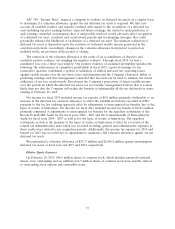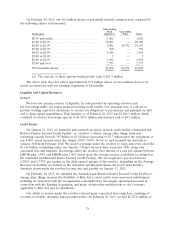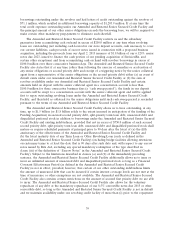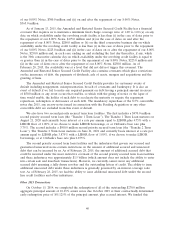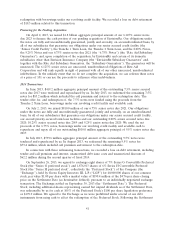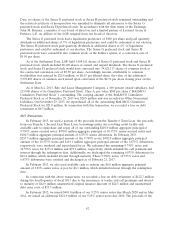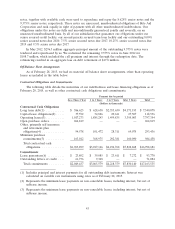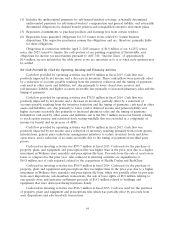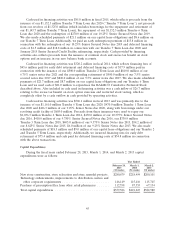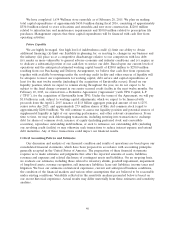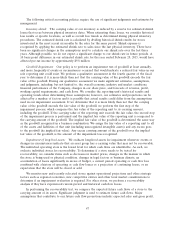Rite Aid 2015 Annual Report Download - page 47
Download and view the complete annual report
Please find page 47 of the 2015 Rite Aid annual report below. You can navigate through the pages in the report by either clicking on the pages listed below, or by using the keyword search tool below to find specific information within the annual report.The following critical accounting policies require the use of significant judgments and estimates by
management:
Inventory shrink: The carrying value of our inventory is reduced by a reserve for estimated shrink
losses that occur between physical inventory dates. When estimating these losses, we consider historical
loss results at specific locations, as well as overall loss trends as determined during physical inventory
procedures. The estimated shrink rate is calculated by dividing historical shrink results for stores
inventoried in the most recent six months by the sales for the same period. Shrink expense is
recognized by applying the estimated shrink rate to sales since the last physical inventory. There have
been no significant changes in the assumptions used to calculate our shrink rate over the last three
years. Although possible, we do not expect a significant change to our shrink rate in future periods. A
10 basis point difference in our estimated shrink rate for the year ended February 28, 2015, would have
affected pre-tax income by approximately $9.8 million.
Goodwill Impairment: Our policy is to perform an impairment test of goodwill at least annually,
and more frequently if events or circumstances occurred that would indicate a reduced fair value in our
sole reporting unit could exist. We perform a qualitative assessment in the fourth quarter of the fiscal
year to determine if it is more likely than not that the carrying value of the goodwill exceeds the fair
value of the goodwill. During our qualitative assessment we make significant estimates, assumptions,
and judgments, including, but not limited to, the overall economy, industry and market conditions,
financial performance of the Company, changes in our share price, and forecasts of revenue, profit,
working capital requirements, and cash flows. We consider the reporting unit’s historical results and
operating trends when determining these assumptions; however, our estimates and projections can be
affected by a number of factors and it is possible that actual results could differ from the assumptions
used in our impairment assessment. If we determine that it is more likely than not that the carrying
value of the goodwill exceeds the fair value of the goodwill, we perform the first step of the
impairment process, which compares the fair value of the reporting unit to its carrying amount,
including the goodwill. If the carrying value of the reporting unit exceeds the fair value, the second step
of the impairment process is performed and the implied fair value of the reporting unit is compared to
the carrying amount of the goodwill. The implied fair value of the goodwill is determined the same way
as the goodwill recognized in a business combination. We assign the fair value of a reporting unit to all
of the assets and liabilities of that unit (including unrecognized intangible assets) and any excess goes
to the goodwill (its implied fair value). Any excess carrying amount of the goodwill over the implied
fair value of the goodwill, is the amount of the impairment loss recognized.
Impairment of long-lived assets: We evaluate long-lived assets for impairment whenever events or
changes in circumstances indicate that an asset group has a carrying value that may not be recoverable.
The individual operating store is the lowest level for which cash flows are identifiable. As such, we
evaluate individual stores for recoverability. To determine if a store needs to be tested for
recoverability, we consider items such as decreases in market prices, changes in the manner in which
the store is being used or physical condition, changes in legal factors or business climate, an
accumulation of losses significantly in excess of budget, a current period operating or cash flow loss
combined with a history of operating or cash flow losses or a projection of continuing losses, or an
expectation that the store will be closed or sold.
We monitor new and recently relocated stores against operational projections and other strategic
factors such as regional economics, new competitive entries and other local market considerations to
determine if an impairment evaluation is required. For other stores, we perform a recoverability
analysis if they have experienced current-period and historical cash flow losses.
In performing the recoverability test, we compare the expected future cash flows of a store to the
carrying amount of its assets. Significant judgment is used to estimate future cash flows. Major
assumptions that contribute to our future cash flow projections include: expected sales and gross profit,
47


